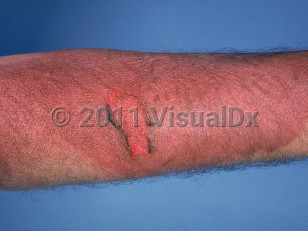All burns (with the exception of minor superficial burns) require medical treatment with wound care and pain control (avoid aspirin in children). For any burn secondary to possible child abuse, admit to hospital unless the child is able to return to a safe location.
- Airway, breathing, and circulation should be assessed first.
- Fluid resuscitation is a cornerstone, critical aspect of burn management.
- Minor burns should be cooled with cold / wet compresses and covered loosely with sterile gauze. Antibiotic ointment may be applied.
- Aggressive wound care is essential to prevent burn wound colonization, particularly in children, who are at higher risk for burn wound infection.
- Depending on the severity of the burn, surgical debridement, escharotomy, or fasciotomy may be necessary as the first step of skin burn management. The ultimate goal is to prevent wound infection and to close / skin graft the defect to reduce morbidity and mortality.
- Thermal burns
- Full-thickness burns
- Partial-thickness burns affecting 10% or more of total body surface area
- Any deep-partial- or full-thickness burns involving the face, hands, genitalia, feet, or perineum or over any joints
- Patients with burns and other comorbidities
- Patients with concomitant traumatic injuries
- Poorly controlled pain
- All patients with suspected inhalation injury
- Pediatrics (≤14 years of age, or <30 kg) – All pediatric burns may benefit from burn center referral due to pain, dressing change needs, rehabilitation, patient / caregiver needs, or nonaccidental trauma.
- All chemical injuries
- Electrical injury
- All high-voltage (≥1,000 V) electrical injuries
- Lightning injury
Thermal and electrical burns of the skin can result in painful and debilitating injuries and in some instances may be fatal. With any burn injury to the skin, it is important to obtain an accurate history of the manner, duration, and intensity of the exposure. In children who present with a burn, the history and physical examination are extremely important to recognize any possibility of child abuse or neglect.*
Scald burns are the most common type of thermal burn to the skin. Severity depends on duration and on the viscosity of the liquid involved. Other types of thermal burns are flame burns, contact burns, and flash burns. E-cigarettes and exploding lithium batteries from cell phones have been associated with thermal burns.
Electrical burns of skin are of two main types, depending on the voltage involved:
- High voltage (>1000 volts)
- Low voltage (<1000 volts)
Numerous vital functions of the skin, including fluid homeostasis, thermoregulation, immunologic functions, neurosensory functions, metabolic functions, and primary protection against infection (by acting as a physical barrier), can be impaired by burn injury. In particular, the skin barrier is damaged to various degrees, allowing pathogens a direct route to infiltrate / infect the body. Careful physical examination is necessary to determine the depth of skin burn, total body surface area (TBSA) involved, and injury to any other vital organs.
To determine the TBSA involved, one can use the "rule of nines" or the Lund-Browder chart. It is important to note that because of differences in body proportion, the percentage assigned for each body area is different in adults and children.
Depth of skin injury in burn is classified as follows:
- Superficial (1st degree) – Involves the epidermis only.
- Partial thickness (2nd degree) – Involves all of the epidermis and part of the dermis. Characterized further according to the depth of dermal injury: superficial partial thickness or deep partial thickness.
- Full thickness (3rd degree) – Involves all of the epidermis and the dermis.



 Patient Information for
Patient Information for 
